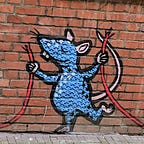Travelogue: Stolpersteine
Since high school I’ve been hearing the George Santayana quote that “those who cannot remember the past are condemned to repeat it.” Is it true? I’d prefer to think not, which is why I wondered in my last post whether we might be better off if historical quarrels were forgotten.
Sadly, the preponderance of evidence gathered over a lifetime leads me to believe Santayana was right. The question is not whether to forget the past, but how to convey it so succeeding generations avoid our mistakes. With its countless memorials, Berlin may be the best place to observe how well we’re doing on that score. The results, I think, are mixed.
The Memorial to the Murdered Jews of Europe occupies nearly five acres of prime real estate by the Brandenburg Gate, within sight of the American embassy and the Reichstag.
The memorial consists of some 2700 rectangular blocks lined up in neat rows that get taller the farther in you go. Here’s a better look.
The concept is similar to Maya Lin’s Vietnam War memorial in Washington DC: as you go in, you become overwhelmed, and the less readily you can find a way out. But I find Lin’s work more poignant because it personalizes the tragedy by including the name of every American soldier killed in the conflict. The Berlin counterpart is just drab concrete blocks that kids can run through and play hide-and-seek in (although none did while we were there, and a plaque in front of the memorial requests somber behavior). It’s hard to feel an emotional connection — any connection — to concrete.
Nearby are smaller memorials to the gay and Sinti/Roma victims of the Nazis. Other official memorials are sprinkled around town. The most garish is the Soviet War Memorial built in 1945 to honor the thousands of Russian soldiers killed in the battle for Berlin. It’s flanked by a pair of tanks. The German government maintains the memorial as part of the 1990 agreement allowing reunification.
Not every memorial is government-sponsored or -maintained. Berlin also has private memorials, many of which are more affecting than the state gestures. We were on the elevated train (the S-Bahn) when we first saw the Kaiser Wilhelm Memorial Church.
After the war, the church left the ruins standing as a testament to inhumanity and dedicated an adjacent gallery to reconciliation with other cultures and faiths. The ruins make a compelling sight, a sobering reminder of modern warfare’s destructiveness.
But the most moving private memorials, from our perspective, are stolpersteine, or stumbling stones, four-inch brass squares discreetly laid in sidewalks near the homes of people murdered by the Nazis. You won’t literally stumble over them; the stones are flush with the sidewalk. Instead you stumble upon them by looking down and noticing them almost by accident. We first discovered them in Amsterdam, where four were set in front of our little hotel, but they were installed in Berlin and Cologne first.
Big numbers numb us; as Stalin reputedly said, a single death is a tragedy, a million deaths a statistic. The stolpersteine personalize the Nazis’ mass slaughter so we can feel it. “Perhaps the Hirschel family was sitting right here when they were ripped from everything they loved, including one another,” we speculated in our cozy room, imagining how we would feel in that situation. Those emotions were difficult to dispel.
Same story for Cold War memorials: the more personal, the more haunting. Checkpoint Charlie is a tourist trap where obliging vendors will stamp your passport as having been to East Germany. (Is that even legal?) The more affecting memorial is away from the crowds along Bernauer Strasse, where a block-wide swath of grass has replaced the death zone between East Germany’s inner and outer barriers to the West, and exhibit stations along the route include wrenching recorded testimony from people who had to grapple with their sudden de facto imprisonment.
The Fabulous Wife and I were born in the aftermath of World War II and experienced the Cold War ourselves, so we had a basis for relating to Berlin’s many memorials to twentieth-century calamity. What of all the people under 35 — which at times seemed like everyone else in the city? Do the memorials mean anything to them? If so, will the memorials impel them to do the right thing when the authoritarians rise again?
It seemed to us that young Berliners don’t think much about the memorials — any more than, say, the youth of Washington DC do about the statues and monuments around them. When that next authoritarian temptation comes, my guess is that other factors, such as family and peer influence, media habits, and economic status will play a much bigger role in how young people react. Nonetheless, I think it’s better to have the memorials than not. If even a few young people heed their lessons, they may become the Martin Luthers whose butterfly flight brings on the cleansing hurricane.
